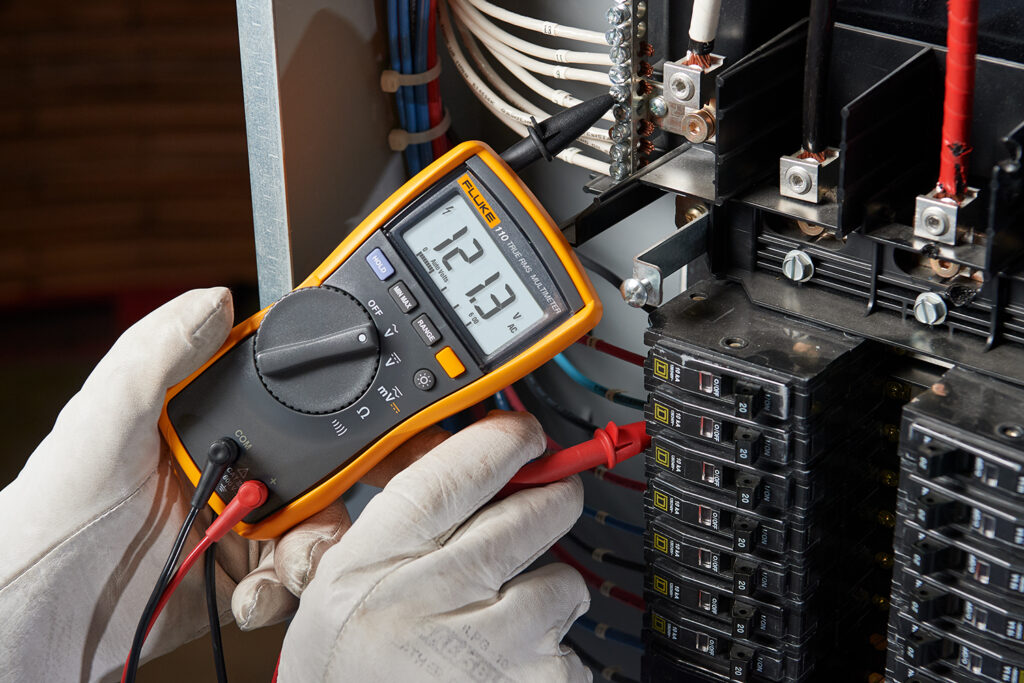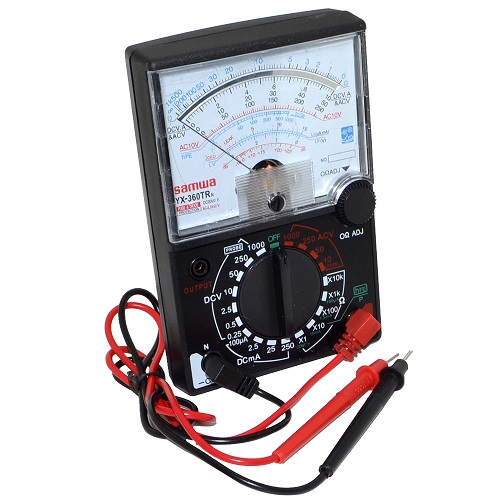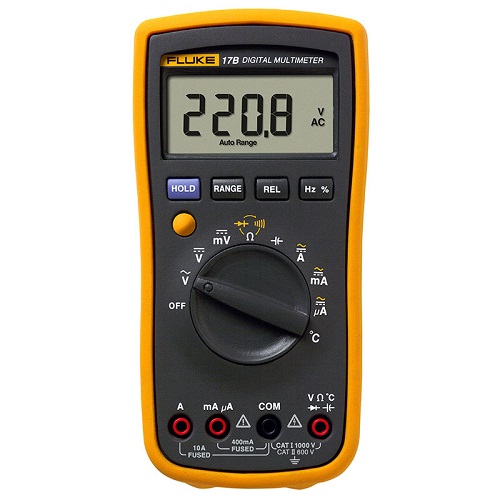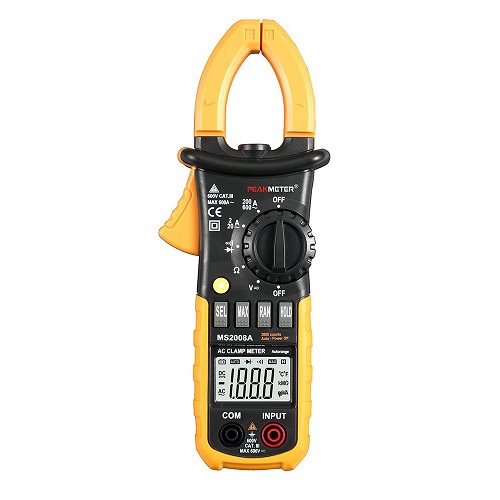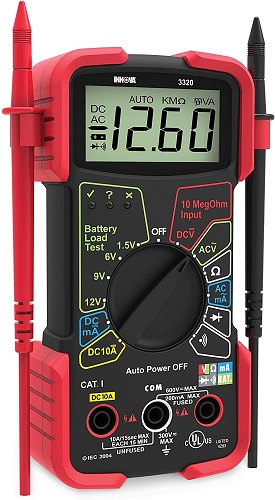There are different types of multimeters on the market categorized based on their characteristics. A multimeter is an essential measurement instrument, used in every engineering workshop or lab. The main function of this device is to measure the electrical properties of tools. It is also used for wiring purposes in the industry.
At present, multimeters are used for different purposes based on the requirements like dealing with electricity, laboratories, power sources & circuits. The different electrical parameters in the multimeter can be selected using a dial or a rotary switch on the front side of the instrument.
There are different types of multimeters including analog and digital ones. Digital multimeters are further categorized into fluke, clamp, and autoranging. This post presents an overview of these different types of multimeters, but let us first briefly see what a multimeter actually is, and how would it help us without measurements.
The Multimeter: What It Does
A Multimeter is an electronic instrument, every electronic technician and engineer’s widely used piece of test equipment. A multimeter is mainly used to measure the three basic electrical characteristics of voltage, current, and resistance. It can also be used to test the continuity between two points in an electrical circuit. This post mainly introduces the basic information about multimeters, applications, and types of multimeters are in. Let’s see all of these.
The multimeter has multi functionalities such as acting like an ammeter, voltmeter, and ohmmeter. It is a handheld device with positive and negative indicator needles over a numeric LCD digital display. Multimeters can be used for testing batteries, household wiring, electric motors, and power supplies.
These instruments are capable of different readings based on the model. So, basic types of multimeters are mainly used to measure amperage, resistance, voltage, checks continuity, and a complete circuit can be tested like the following.
- Resistance in Ohms
- Capacity in Farads
- The temperature in Fahrenheit/ Celsius
- AC Voltage & Amperage
- Inductance Henrys
- DC Voltage & Amperage
- Frequency in Hz
- Conductance in Siemens
- Decibels
- Duty Cycle
To some types of multimeters, special sensors or accessories can be attached for extra readings like acidity, light level, alkalinity, wind speed & relative humidity.
Types of Multimeters: Analog Multimeter
The Analog Multimeter or VOM (Volt-Ohm-Milliammeter) is constructed using a moving coil meter and a pointer to indicate the reading on the scale. The moving coil meter consists of a coil wound around a drum placed between two permanent magnets.
As current passes through the coil, the magnetic field is induced in the coil which reacts with the magnetic field of the permanent magnets and the resultant force causes the pointer attached to the drum to deflect on the scale, indicating the current reading. It also consists of springs attached to the drum which provides an opposing force to the motion of the drum to control the deflection of the pointer.
For the measurement of DC, the D’Arsonval movement described above can be directly used. However, the current to be measured should be lesser than the full-scale deflection current of the meter. For higher currents, the current divider rule is applied. Using different values of shunt resistors, the meter can also be used for multi-range current measurements. For current measurement, the instrument is to be connected in series with the unknown current source.
For the measurement of DC voltage, a resistor is connected in series with the meter, and the meter resistance is taken into account in such a way that the current passing through the resistor is the same as the current passing through the meter and the whole reading indicates the voltage reading. For voltage measurement, the instrument is to be connected in parallel with the unknown voltage source. For multirange measurement, different resistors of different values can be used, which are connected in series with the meter.
For measurement of resistance, the unknown resistance is connected in series with the meter and across a battery, such that the current passing through the meter is directly proportional to the unknown resistance. For AC voltage or current measurement, the same principle is applied, except for the fact that the AC parameter to be measured is first rectified and filtered to get the DC parameter and the meter indicates the RMS value of the AC signal.
The advantages of an Analog Multimeter are that it is inexpensive, doesn’t require a battery, and can measure fluctuations in the readings. The two main factors affecting the measurement are sensitivity and accuracy. Sensitivity refers to the reciprocal of the full-scale deflection current and is measured in ohms per volt.
Types of Multimeters: Digital Multimeters
We mostly used a multimeter is a digital multimeter (DMM). The DMM performs all functions from AC to DC other than analog. It has two probes positive and negative indicated with black and red color as shown in the figure. The black probe is connected to COM JACK and the red probe is connected by the user’s requirement to measure ohm, volt, or amperes.
The jack marked VΩ and the COM jack on the right of the picture are used for measuring voltages, and resistance, and for testing a diode. The two jacks are utilized when an LCD shows what is being measured (volts, ohms, amps, etc.). Overload protection prevents damage to the meter and the circuit and protects the user.
The Digital Multimeter consists of an LCD, a knob to select various ranges of the three electrical characteristics, an internal circuitry consisting of signal conditioning circuitry, and an analog-to-digital converter. The PCB consists of concentric rings that are connected or disconnected based on the position of the knob. Thus as the required parameter and the range are selected, the section of the PCB is activated to perform the corresponding measurement.
To measure the resistance, current flows from a constant current source through the unknown resistor, and the voltage across the resistor are amplified and fed to an Analog to Digital Converter and the resultant output in form of resistance is displayed on the digital display. To measure an unknown AC voltage, the voltage is first attenuated to get the suitable range and then rectified to a DC signal and the analog DC signal is fed to an A/D converter to get the display, which indicates the RMS value of the AC signal.
Similarly to measure an AC or DC, the unknown input is first converted to a voltage signal and then fed to an analog-to-digital converter to get the desired output(with rectification in case of an AC signal). The advantages of a Digital Multimeter are its output display which directly shows the measured value, high accuracy, and ability to read both positive and negative values.
Types of Multimeters: Fluke Multimeter
The fluke digital multimeter can be designed with various collaboration functions. Generally, it includes a large display and this instrument is used to measure the voltage as well as electrical resistance. Some kinds of devices are available with advanced features to measure humidity, duty cycle, pressure, frequency temperature, etc. The fluke multimeter is one of the most frequent and famous instruments.
This kind of multimeter is mainly used for calibration efforts and used to calibrate currents, volts & other electrical units.
The fluke multimeters are protected against the transient voltage. It is a small portable device used to measure voltage, current, and test diodes. The multimeter has multi selectors to select the desired function. The fluke MM automatically ranges to select most measurements. This means the magnitude of the signal does not have to be known or determined to take an accurate reading, it is directly moved to the appropriate port for the desired measurement. The fuse is protected to prevent damage if connected to the wrong port.
Types of Multimeters: Clamp Digital Multimeter
The clamp digital multimeter is used to measure the electricity flow. As the name suggests, this multimeter includes the feature namely the clamp which measures the amps whenever the probes measure the volts. The adjustment of power utilization can be done by multiplying the reading of voltage with the amps. This multimeter also includes an additional feature that is different kinds of settings. The appropriate feature is used while measuring.
This kind of multimeter includes fixed tools for measuring the current flow. This device extremely changes from the fluke type because, in fluke multimeter, it utilizes a clamp to measure the flow of current. So, this instrument is usually recommended for professionals only.
Types of Multimeters: Autoranging Multimeter
The auto-ranging multimeter is a simple multimeter to utilize even though it is similarly the most costly of all kinds of digital multimeters. This multimeter includes a knob in the center and has less position. So it doesn’t switch automatically to measure. This instrument is applicable in simple projects. For beginners as well as electricians at home, this instrument is highly recommended. Generally, it measures a single component at a time.
Choosing from Different Types of Multimeters
Click here for a descriptive video of how to choose between different types of multimeters.
Buy Equipment or Ask for a Service
By using Linquip RFQ Service, you can expect to receive quotations from various suppliers across multiple industries and regions.
Click Here to Request a Quotation From Suppliers and Service Providers
Read More In Linquip
- Types of Thermometers: All You Need to Know
- A Quick Look at Types of Proximity Sensors
- Types of Insulator Materials: Ultimate Guide
- A Good Look at Types of Thermostats
- Multimeter Parts: All You Need to Know about All the Components
- Difference Between Multimeter and Voltmeter
- 13 Types of Tachometers With Their Functions & Advantages

